Enjoy your favorite tracks with these high-quality car subwoofers
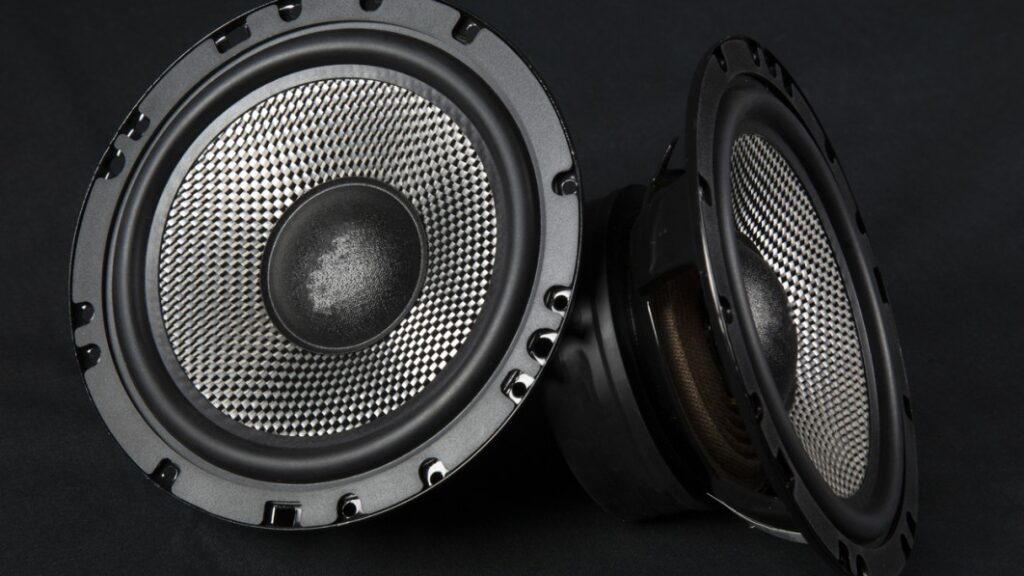
Autoblog may receive a share from purchases made via links on this page. Pricing and availability are subject to change.
Want to turn a boring car ride into a fun time? We’ve researched top-quality car subwoofers to give you an incredible sound experience on the road. If you’re constantly on the lookout for equipment that can deliver the sound you crave, there’s no better way to go about it than investing in high-quality car subwoofers.
Car subwoofers are far more than just typical speakers, as they deliver superior music quality and can lead to ultimate listener satisfaction. Adding subwoofers to your car’s sound system isn’t only about increasing the volume or the bass — it’s also about bringing the low-end output into balance, which will play an important role when you hit the road. Finding a top-notch car subwoofer is not an easy task — the process needs careful attention and also demands your valuable time. To help you out, we’ve already done all the hard work for you — check out our list of top-quality car subwoofers available today to help you better enjoy your next trip in the car.
Top car subwoofers of 2023
$249.95 at Amazon
Pros
Built-in amp matches subwoofer performance – 150W RMS or 450W Peak
12″ subwoofer
35 Hz – 120 Hz frequency response
Comes with remote control
Cons
May be prone to heating up if not installed correctly
JBL is a popular speaker brand for a reason. Generally, they offer solid sound at a decent price and this pick is no exception. This 12-inch subwoofer offers a frequency response from 35 Hz – 120 Hz, has a built-in amplifier and comes with its own remote control. If you can snag it for a discount, even better.
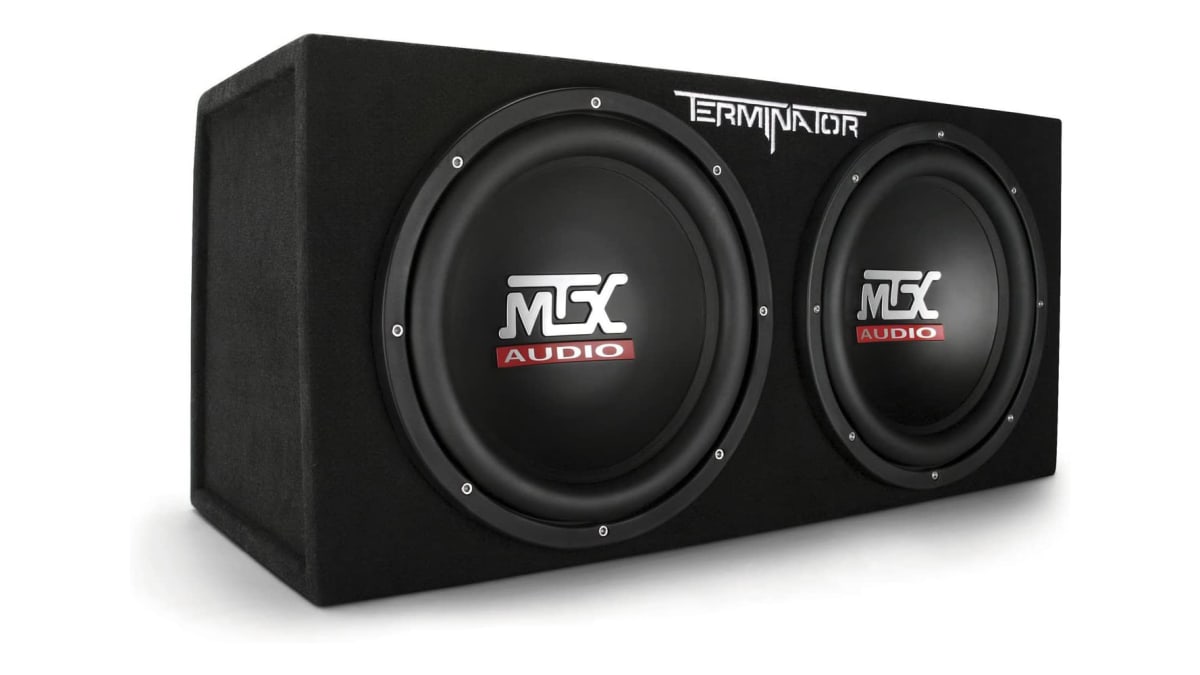
$149.95 at Amazon
Pros
5.9″ MDF Construction
2 ohm impedance
2 12-inch speakers
10 Hz – 150 Hz frequency response
Cons
Installation may take an hour or more
This MTX subwoofer is a great choice for someone who wants a good bang for their buck. The enclosure houses two 12-inch speakers and features a 2 ohm impedance rating and a 10 Hz – 150 Hz frequency response. One reviewer commented about how easy it was to install and mentioned that “it hit hard enough to knock my rear view mirror off center,” which sounds ridiculous, but that’s kind of what you want out of a sub – right?
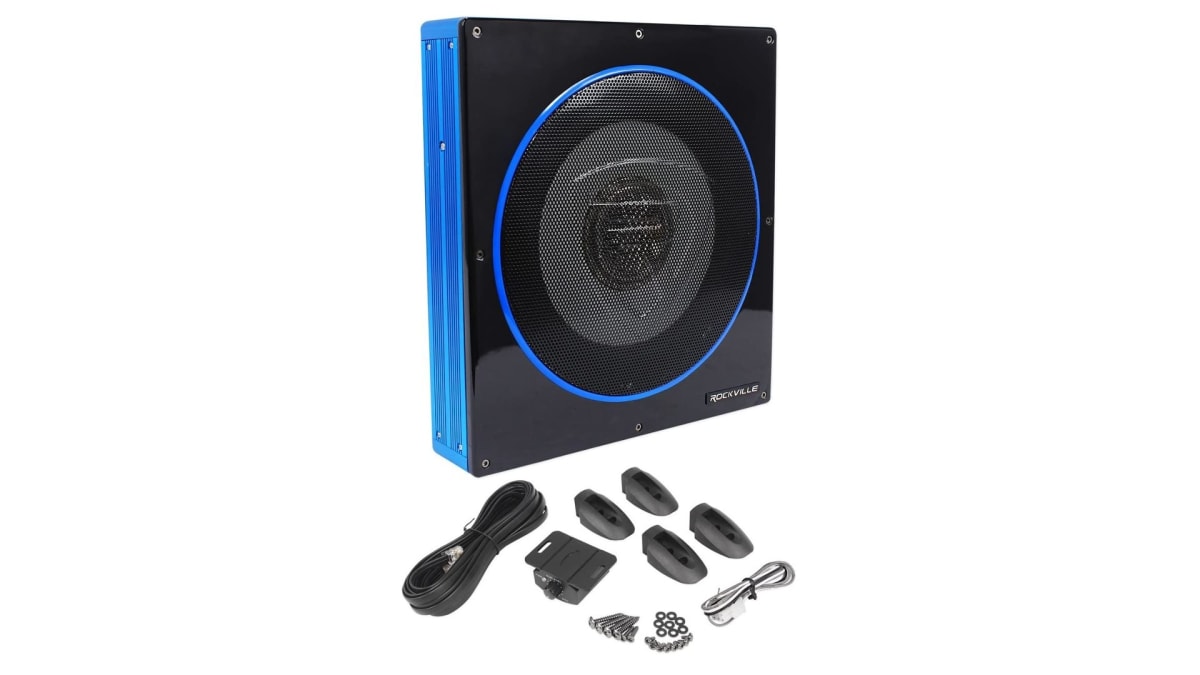
$149.95 at Amazon
The RW10CA car subwoofer is an all-in-one solution for bass in your vehicle that won’t take up a lot of room. With a thickness of only 2.7″, this sub enclosure will almost certainly fit easily beneath your seat. The amplifier is pre-installed, making installation and wiring straightforward. Due to its high-level inputs, this car subwoofer doesn’t require an additional wire to turn on and off as a typical receiver would — when it detects an audio signal, it will turn on your radio and you’ll be able to hear it. The amplifier in this subwoofer system shuts off automatically when the music is turned off, and it contains volume control and a subsonic filter to remove frequencies the human ear can’t detect. A low-pass filter, timing control, and bass enhancement all come in the package, making this car subwoofer an all-around solid option.
Pros
Slim and elegant design
Auto turn-on technology
Money-back guarantee
Cons
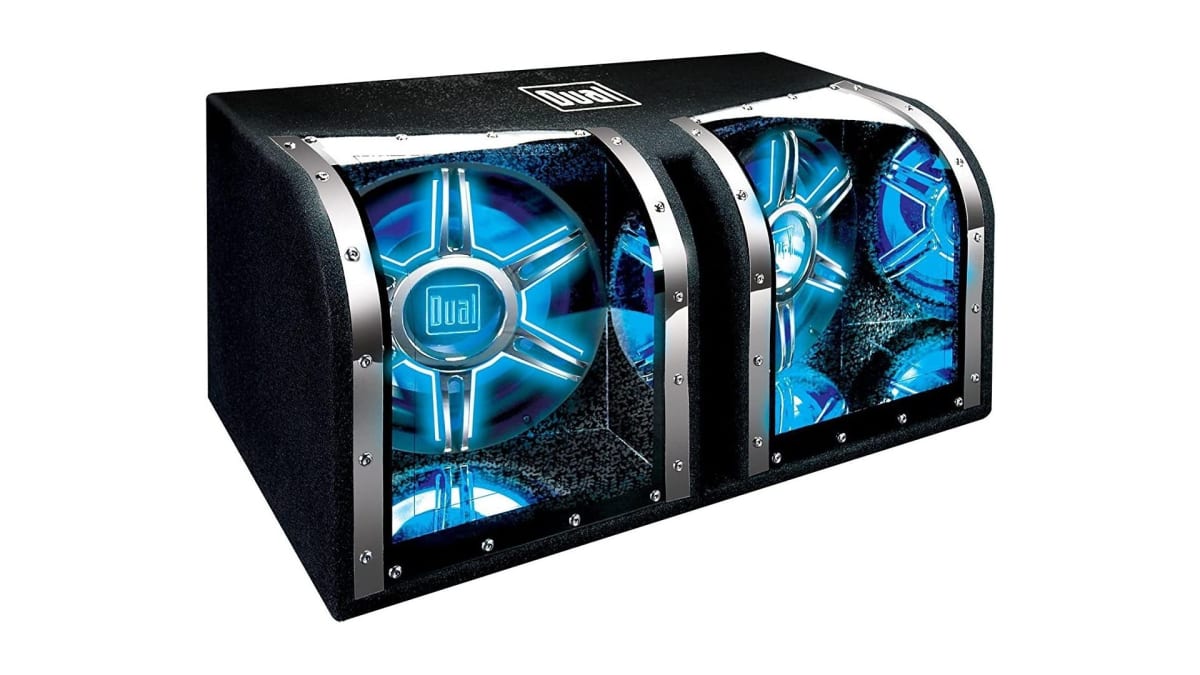
$159.99 at Amazon
With 1,100 Watts of maximum output, these car subwoofers from Dual Electronics can really pack a punch. Thanks to their uniquely tuned port’s computer-aided construction and its use of 2.5″ diameter voice coils, these subwoofers offer improved output efficiency. In addition to their high max power, these car subwoofers have a resonant frequency of 30-200 Hz, making them suitable for even the most demanding bass heads. The built-in ventilation control circuitry on these car subwoofers helps keep your system cool for optimal bass production and hours of non-stop audio enjoyment. To provide you with the highest possible sound quality in the car, these subwoofers come with a sound medium density fiberboard (MDF) structure and upper in-line carpet.
Pros
Increased output capability
Curved plexiglass window with LED bulb system
Loud and accurate bass
Cons
Not ideal for cars with less space
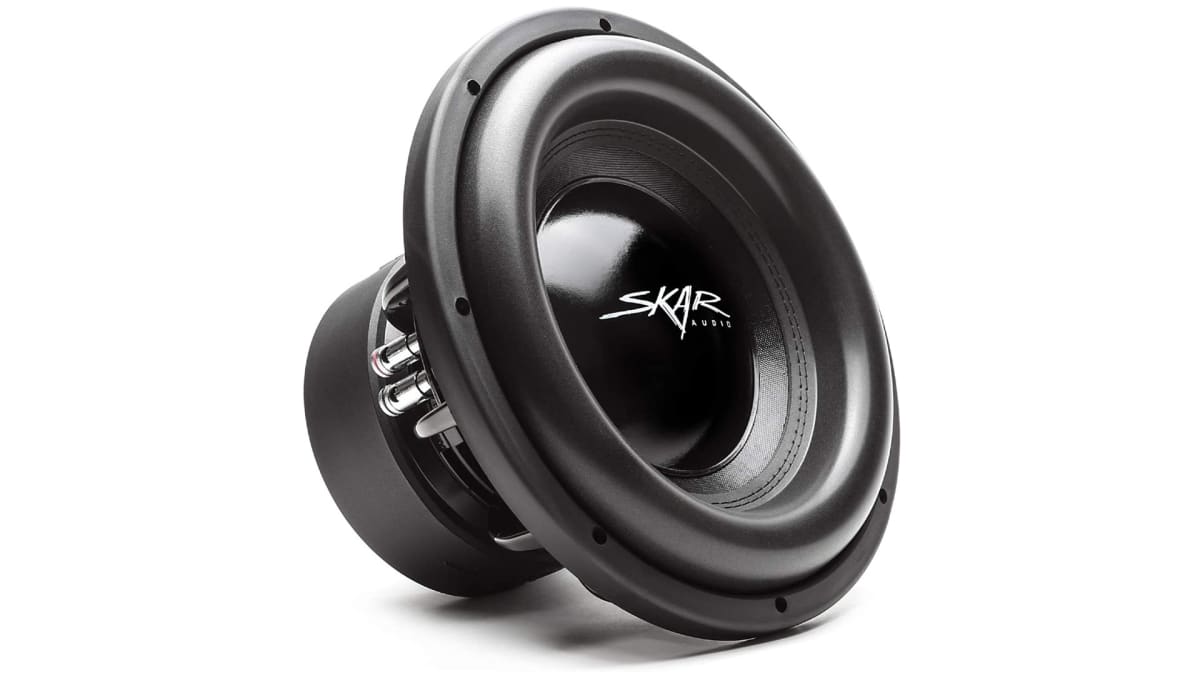
$195.49 at Amazon
The Skar Audio EVL-12 car subwoofer completely changes the way low-end music is reproduced. The high level of engineering that went into creating this car subwoofer shows in its impressive sound quality and performance. Thanks to innovative design elements, this car subwoofer can generate powerful and highly accurate bass, and it’s a solid choice if you’re entering your vehicle into competitions or if you just want to cruise around and jam out. Its motor provides clean, consistent energy to the subwoofer, and it also has cooling ports that help keep it cool even under heavy use for extended periods.
Pros
Offers deep, powerful bass
Efficient cooling system for extended use
Exceptional core specs
Cons
Requires amplifiers stable at low impedances
Buyer’s guide to finding a car subwoofer
When it comes to reproducing low frequencies, regular speakers just can’t compete with the power of car subwoofers. A great subwoofer will elevate your listening experience no matter which genre of music you choose or how loud or softly you prefer to listen to it. Car subwoofers come with varying features that suit a wide range of vehicles, budget ranges, and personal preferences. To pick a car subwoofer that ticks all your boxes, you must consider several factors.
Types of car subwoofers
Passive subwoofers
Passive subwoofers need a separate amplifier to power them. The subwoofer’s passive design necessitates greater power to reproduce lower frequencies. Large rooms can benefit greatly from passive subwoofers.
Active subwoofers
Active subwoofers are a very popular type of subwoofer because these subwoofers have their own amplifiers included with the subwoofer. The great thing about active subwoofers is how easy it is to connect to them — all you need is a power source and a connection to the receiver’s subwoofer output.
Down-firing/Front-firing subwoofers
As the name implies, a front-firing subwoofer is equipped with a speaker that’s placed so that sound emanates from either its front or sides. Down-firing subwoofers, on the other hand, are positioned so that sound emanates from the subwoofer’s bottom and travels toward the floor. Each of these subwoofers operates similarly, and the choice mostly depends on where you intend to install your subwoofer.
What should I consider when buying a car subwoofer?
Impedance
While low-impedance subwoofers deliver a lot of basses, they often sacrifice quality in the name of a punchy thump. With this in mind, what’s the answer?
It’s a lot of fun to turn up twin 12-inch low-impedance subwoofers in a vented box in the trunk until the license plate sounds like a flipped door stopper. While this is a great novelty, sound quality is critical when trying to discern the subtleties of a track. An amplifier can’t deliver the same amount of power at 4 ohms as this can at 2 ohms, so it’s important to study the spec sheets carefully before buying.
Frequency response
The frequency response of any subwoofer is critical to its overall performance, especially in today’s sub-bass-heavy music creation that presents a difficulty of auditory limbo. How low does your subwoofer have the ability to go? Ones with larger diameters are likely to reach lower frequencies, whereas smaller-diameter subwoofers don’t seem capable of reaching these. The lowest frequency being 35 Hz is an outdated standard, especially given the fact that moderately priced subwoofers are capable of producing a sound below 30 Hz. Because setting up a subwoofer necessitates the tuning of a reduced filter on the receiver, upper-frequency limitations aren’t as important as they once were. The low-pass filter must be set between 70 and 80 Hz, which is substantially below the upper-frequency limitations of common subwoofers.
Enclosure requirements
You should consider if you want a closed or ported enclosure for your passive subwoofer. Although ported enclosures are bigger and louder, closed enclosures are much more compact and have a more focused bass response. When using a ported enclosure, be sure to research the ideal port frequency and required enclosure volume for the subwoofer. To ensure that the enclosure will fit in your vehicle, all you have to do is compare the specifications and take measurements.
Pricing
Because the subwoofer industry is so diverse, there are options for everyone, from audiophiles to college students on a tight budget. Multiple elements such as beefier construction, more power handling, and improved sound clarity can all increase prices considerably. You can spend as little as $100 or as much as $1,000+, as evidenced by the subwoofers on our list.
What are the benefits of car subwoofers?
Wherever you want, the subwoofer goes
The sound waves which create bass notes are just too long for our ears to distinguish a source spatially, but luckily the car subwoofer does not have the same restriction. Because the duration of those notes is the same reason why a loudspeaker needs additional space and size to go low, this is a positive.
You’ll need a subwoofer to hear deep bass notes, as it has a much wider speaker enclosure but is also much louder than what fits in a vehicle door.
Improvement in the performance of higher frequencies
Even if typical car stereo speakers could reproduce all bass notes, you wouldn’t necessarily want to. It takes a great deal of power to create lengthy sound waves like bass notes, so when one speaker set tries to replicate a complete range of frequencies, it results in the bass notes using much of the power and diminishing the whole system.
Subwoofers, though, are usually by their own amp, so when you add a car subwoofer you can change the crossover frequency as desired. To increase midrange and treble efficiency, your car stereo source will send low bass sounds to the sub while only sending tweeters and woofers to the higher frequencies that they were built to handle.
Smoother, distortion-free sound
Audio perfection is no longer just a dream — it’s possible with a subwoofer-equipped car stereo that’s been properly tuned, letting your speakers reach their full potential and resulting in a more extensive and detailed audio experience. If you dial the level down, you’ll observe the change in quality as much as you discern the difference in power.
There’s no room for bass in stereo speakers
Even though a door-mounted car radio speaker might produce high-frequency signals flawlessly, the less bass it produces and the more distortions it suffers, the thinner the speaker will be. There just isn’t enough room behind car door speakers to effectively reproduce frequencies lower than about 80 Hz, and this is precisely where the finest bass sounds are found.
Tips for using a car subwoofer
Do not utilize the receiver and amplifier’s low-pass filters or crossovers at the same time — use only one of them, but not both at once. The reason for this is that phase distortion occurs around the crossover frequency of each filter or boost, which will muddy the sound
If you have a two-channel amp with a single subwoofer, you can bridge the channels. This will create a large output to the subwoofer, but it’s only suggested if your subwoofer is unpowered
Adjusting a car’s stereo audio settings can make a big difference. Most include a built-in equalization (EQ) that lets you boost the bass, and increasing the 60 Hz sound will increase the subwoofer’s bass
Car Subwoofer FAQs
Q: Why should I go for a car subwoofer?
Subwoofers, like tweeters, are used to fill in bass lines in audio recordings, just like the tweeters on car dashboards or doors. It’s not a bad idea to install a subwoofer if your speakers aren’t producing enough bass — subwoofers can reduce the bass strain on the door as well as parcel shelf speakers, improving their clarity and increasing their longevity. To avoid damaging the door and trunk speakers, use an aftermarket wire harness with a hi-pass filter.
Q: What frequency range do I need?
Subwoofers typically have a frequency range of around 20–200 Hz. Professional concert audio system subwoofers can deliver lower bass frequencies than the 80-Hz limit of THX-certified systems.
Q: Does the location of the port affect the sound quality?
It shouldn’t make any difference as long as the airflow from it reaches the sub’s interior structure.







